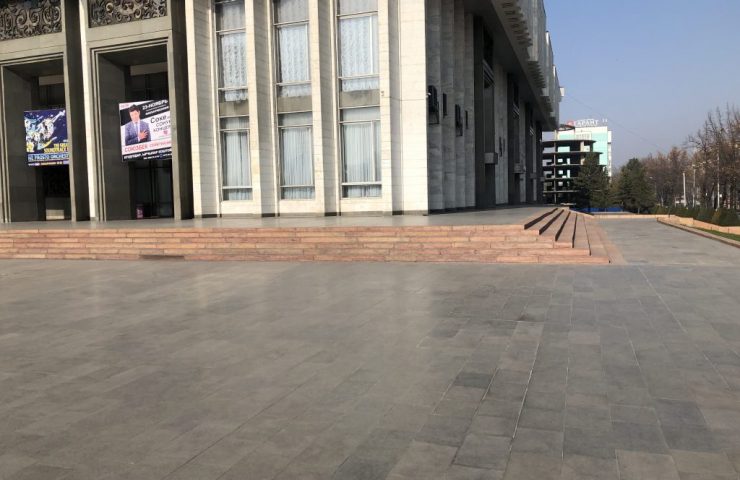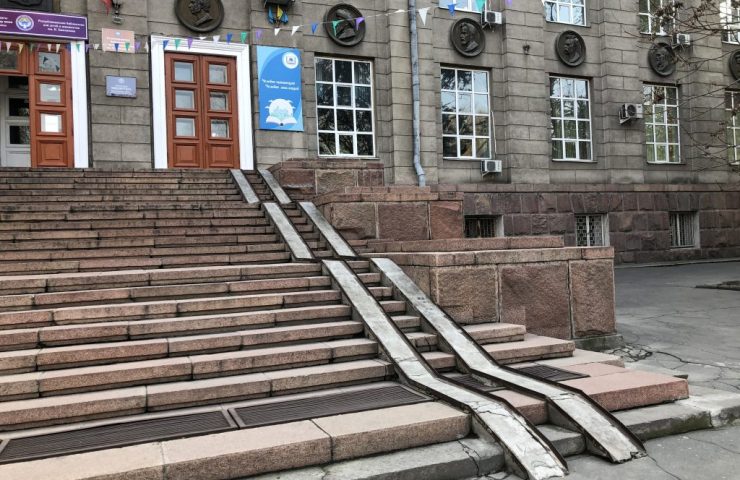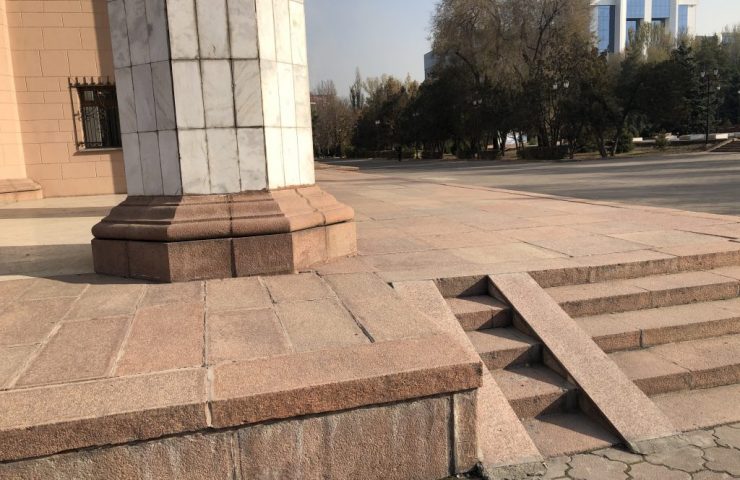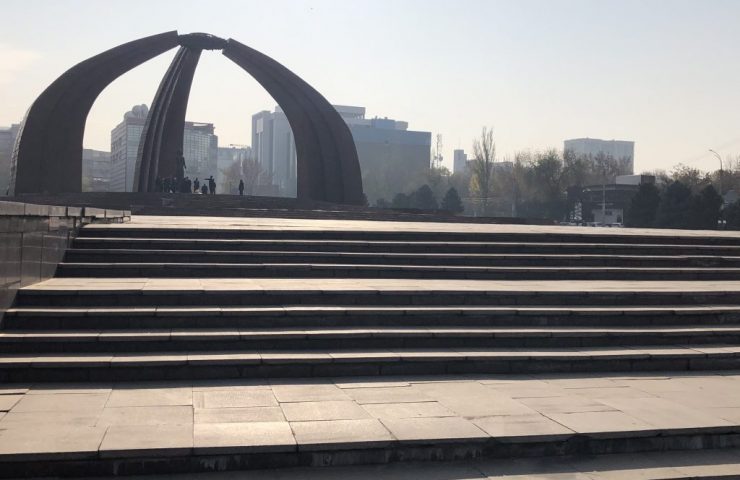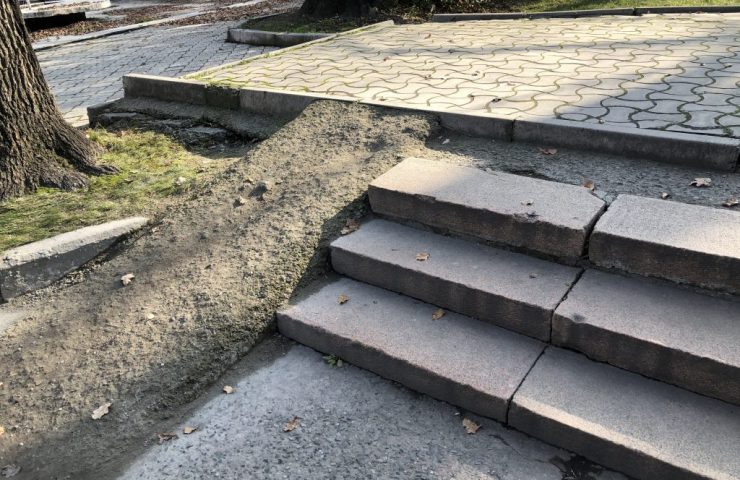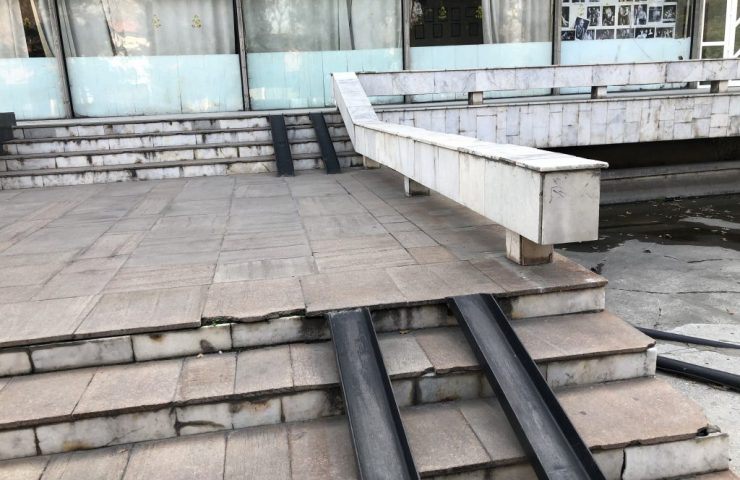There have been many talks about “smart”, modern and safe city in Kyrgyzstan lately. Although Bishkek is one step closer to the overall digitalisation, the city that doesn’t have accessible environment for certain groups of people cannot be called a safe city.
Follow us on Facebook
Mothers with strollers, elderly people with mobility problems, and physically disabled people that use wheelchairs still need to choose routes to make their travel around the city comfortable. “Proper” ramps and stair lifts are not widely accessible in the capital.
Speaking of the “properness” of ramps, we should turn to the construction norms and rules (SNiP) of the Kyrgyz Republic. SNiP 35-01-2001 is titled “Accessibility of buildings and structures to mobility impaired groups of people”.
According to it, the slope of the ramp must be 5 to 10 per cent and the structure must be equipped with double ramps. The most preferable frame is a mesh surface that is adhesive and protected from ice crust.
Such ramps can be counted on one hand in Bishkek. Not all new public buildings in Bishkek can be smoothly approved by the State Inspectorate for Environmental and Technical Safety.
What was the situation like in the USSR?
The Soviet-age buildings, the majority of which are listed as places of interest of Bishkek, are also not accessible for mobility impaired citizens and mothers with strollers.
The T.Satylganov State Philharmonic Hall, the building of Oktyabr cinema, the Zh.Balasagyn Kyrgyz National University, the K.Bayalinov Republican Library, the A.Maldybaev Opera and Ballet Theatre.
Lack of ramps in the eastern entrance of the building of the philharmonic hall. Photo: CABAR.asia
Channel ramp at incorrect slope in the K.Bayalinov library. Photo: CABAR.asia
Ramp at the A.Maldybaev Opera and Ballet Theatre. Photo: CABAR.asia
The two latter objects have ramps, yet a rare wheelchair user would take a risk to use the steep slope track ramp in the library or a formal “slope” that leads right into the column and is made on the theatre stairs that are hardly visible.
The gap between the dates of completion of the two buildings is quite big. For example, the Opera and Ballet Theatre was built in 1955, and the philharmonic hall in 1980. However, both objects were repaired and renovated in the last two years. The construction estimates didn’t contain costs for the installation of ramps.
A member of the union of architects of the Kyrgyz Republic, Beisen Kariev, emphasised that SNiP has always existed. Soviet architects interpreted these norms as a necessity for moms with strollers rather than for disabled people.

“The examination and compliance department usually connived at this ramp requirement. Since the early 2000s, the requirements became tougher. Now the examination and compliance department doesn’t approve projects if they provide for no ramps. The list of documents for examination has a ramp requirement, which, in my opinion, is in the top three requirements after the general layout and building plan,” Kariev said.
He noted that today students of architectural departments focus more on ramp installation and barrier-free city environment. Moreover, old buildings that cannot meet the ramp slope requirement should be equipped with special stair lifts or lifts, which is rather expensive.
“I think today we have initiatives regarding ramp and stair lift installation in public places. However, they are too insignificant on a city scale and are not always well developed,” the architect said.
If the situation with the Soviet-time buildings and their loyalty is clear, the issue of modern, just-built buildings is still unresolved. In spite of Kariev’s words about mandatory compliance with SNiP by today’s developers and competent commission, which approves construction projects, Bishkek is full of inaccessible buildings.
It is as easy as pie to build castles in the sky
State Agency for Architecture, Construction and Public Utility (Gosstroi) of Kyrgyzstan is responsible for development of scientific and technical documentation for construction, as well as supervision of local urban planning and architecture bodies (if we speak about Bishkek, it is BishkekGlavArkhitektura).
Nazgul Koibagarova, the chief of architectural and space planning, architectural appraisal and compliance department of BishkekGlavArkhitektura, confirmed that all developers being legal accountable entities must comply with the above SNiP.
“It’s not just the ramps. Doorways in buildings must be at least 90 cm wide for wheelchair users. If the project doesn’t have this requirement, it won’t be approved,” Koibagarova said.
Thus, two agencies, BishkekGlavArkhitektura and Gosstroi have access to construction document of any development project. Technically, a project without “proper” ramps may not be approved a priori; however, the streets of the capital are full of structures inaccessible for disabled people.
The State Inspectorate for Ecological and Technical Safety is in charge of monitoring of construction processes and compliance with requirements in practice. Officers of this agency comprise the commission that monitors city buildings, including ramps.
However, the State Inspectorate for Ecological and Technical Safety never answered the question of CABAR.asia about the process of monitoring and control of projects under construction and how the state monitors the condition of old ramps.
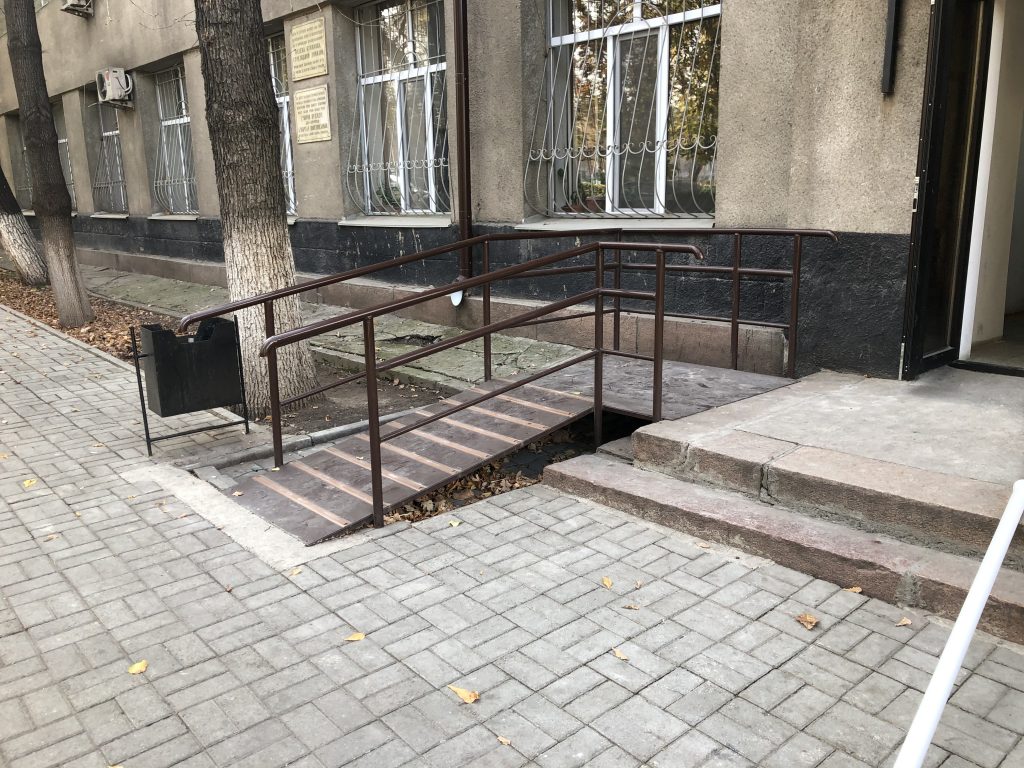
Who else but us?
The activists of Bishkek that joined into the Peshkom Movement repeatedly drew attention to the accessibility of the city environment for wheelchair users and people with strollers. The supervisor of this initiative, Rada Valentina kyzy, said that the barrier-free environment in the capital is available only for vehicles.

“Decision-makers don’t see the problem. If they start using public transport and walking with a stroller, the capital will start to change towards the barrier-free pedestrian environment. When they install ramps just for the sake of appearance, they don’t meet the standards. Ramp slopes are the same as the stair slopes, which is 3-4 times more than the standard requirement,” the activist said.
According to her, business owners must ensure easy accessibility for disabled people and mothers with strollers if they build commercial buildings. The authorities are responsible for the urban spaces.
There’s some progress
Lately, there have been many cases when city authorities focus their attention on accessibility for wheelchair users in the city. Tazalyk municipal enterprise, whose employees install ramps in parks, cooperated with the prominent blogger and activist Askar Turdugulov (more known as blogger Oscar Rise). He is a wheelchair user and “tests” ramps for safety and comfort upon request.
The activist said there’s some progress and now he can afford to enter more public places on his wheelchair.
“There’s some progress because these problems are more frequently covered and spoken out on the internet and social media. If people could totally ignore problems relating to ramps, now they start listening and sometimes they even comply with some requirements,” Turdugulov said.
According to the blogger, the philharmonic hall is still the most inaccessible place in the city. And one of the most hazardous ramps in his own ranking is the track ramp of the Family Medicine Centre No. 8. Its slope is too steep and using it looks like a suicide.

He noted that there are more than 180 thousand people with disabilities in Kyrgyzstan, and even more mothers with strollers. Moreover, it won’t cost much to businesses to install a ramp or design a building without stairs, but no one wants to.
“Despite the ratified UN Convention on the rights of persons with disabilities, our country still has inaccessible buildings. For example, the new section of TSUM. It was completed just recently, and it doesn’t have the ramp, even for the sake of appearance. It has no ramps at all,” Turdugulov said.
The UN Convention on the rights of persons with disabilities was ratified by Kyrgyzstan in March this year. At estimate was made on how much money would be needed to create conditions for persons with disabilities under this convention. The amount voiced by the government was 6.6 billion som (almost 94.5 million dollars), including 5.1 billion (73.024 million dollars) for construction of facilities of persons with disabilities.
The amount seems big, but in terms of ramps it’s not that big. According to the estimates made by economist Iskender Sharsheev, the planned amount can be used to install nearly 500 ramps or about 1,200 hand rails, including installation works.

“In fact, it would be great to see not just figures, but a detailed estimate and approaches to this budget. Now we can say that these funds would be enough to implement the smallest part of the project, not the whole project. Moreover, other questions arise: will municipal buildings or private buildings have ramps? Or owners of private buildings will have to make accessible environment at their own cost,” Sharsheev emphasised.
It’s clear the accessibility problem in Bishkek for wheelchair users and mothers with strollers is discussed more actively and there have been some improvements on this issue. People with mobility problems, activists in the area of barrier-free environment and experts wait for 2020 to see the stages of implementation of the Convention ratified.
However, experts noted that some matters need to be clarified before taking active measures. For example, a commission should be created to be responsible for the creation of the barrier-free city environment for persons with disabilities from A to Z, from documentation development to monitoring of installed structures. Moreover, private businesses could be involved on mutually beneficial terms to solve these problems.
This publication was produced under IWPR project «Forging links and raising voices to combat radicalization in Central Asia»


